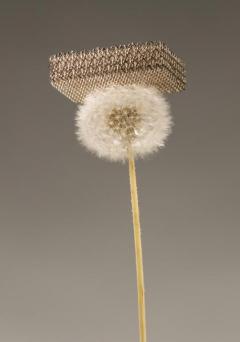Multidisciplinary Team of Researchers Develop World’s Lightest Material
Assistant Professor Lorenzo Valdevit helps develop world’s lightest material
 Assistant Professor Lorenzo Valdevit, Ph.D., Department of Mechanical and Aerospace Engineering, with a team of researchers from HRL Laboratories, LLC; The Henry Samueli School of Engineering at UC Irvine; and the California Institute of Technology announced that they have developed the world’s lightest material with a density of 0.9 mg/cc, approximately one hundred times lighter than Styrofoam™. The results of their research are published in the November 18, 2011 issue of the journal Science.
Assistant Professor Lorenzo Valdevit, Ph.D., Department of Mechanical and Aerospace Engineering, with a team of researchers from HRL Laboratories, LLC; The Henry Samueli School of Engineering at UC Irvine; and the California Institute of Technology announced that they have developed the world’s lightest material with a density of 0.9 mg/cc, approximately one hundred times lighter than Styrofoam™. The results of their research are published in the November 18, 2011 issue of the journal Science.
This new material redefines the limits of lightweight materials because of its unique “micro-lattice” cellular architecture. The researchers were able to make a material that consists of 99.99 percent open volume by designing the 0.01 percent solid at the nanometer, micron and millimeter scales using an innovative fabrication process. “The trick is to fabricate a lattice of interconnected hollow tubes with a wall thickness of 100 nanometers, 1000 times thinner than a human hair,” said lead author Dr. Tobias Schaedler, research staff scientist at HRL.
In addition to its ultra-low density, the material’s cellular architecture gives rise to unprecedented mechanical behavior for a metal, including complete recovery from compression exceeding 50 percent strain and extraordinary high energy absorption.
“The emergence of these unique properties in ultra-light micro-lattices is due to a synergistic interplay of materials size effects at the nano scale and optimal design of the micro and macro-scale architecture,” Valdevit says. “Our UC Irvine research group was primarily in charge of the latter. The development of micro-architected materials through optimal topological design, numerical modeling and mechanical characterization across multiple length scales is the main research thrusts in our lab.”
Developed for the Defense Advanced Research Projects Agency (DARPA), the novel material could be used for battery electrodes, catalyst supports, and acoustic, vibration or shock energy damping.
Dr. Bill Carter, manager of the Architected Materials Group at HRL describes the vision for these micro-lattice materials by drawing parallels to large structures: “Modern buildings, exemplified by the Eiffel Tower or the Golden Gate Bridge, are incredibly light and weight-efficient by virtue of their architectures. We are revolutionizing lightweight materials by bringing this concept to the materials level and designing their architectures at the nano and micro scales.”
